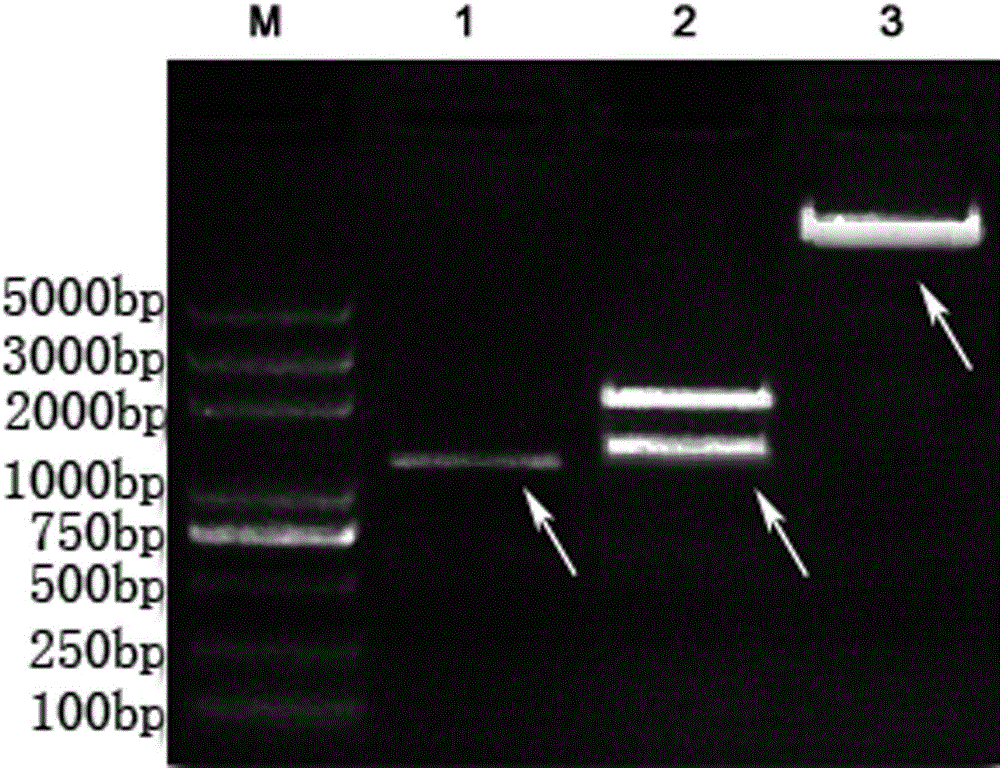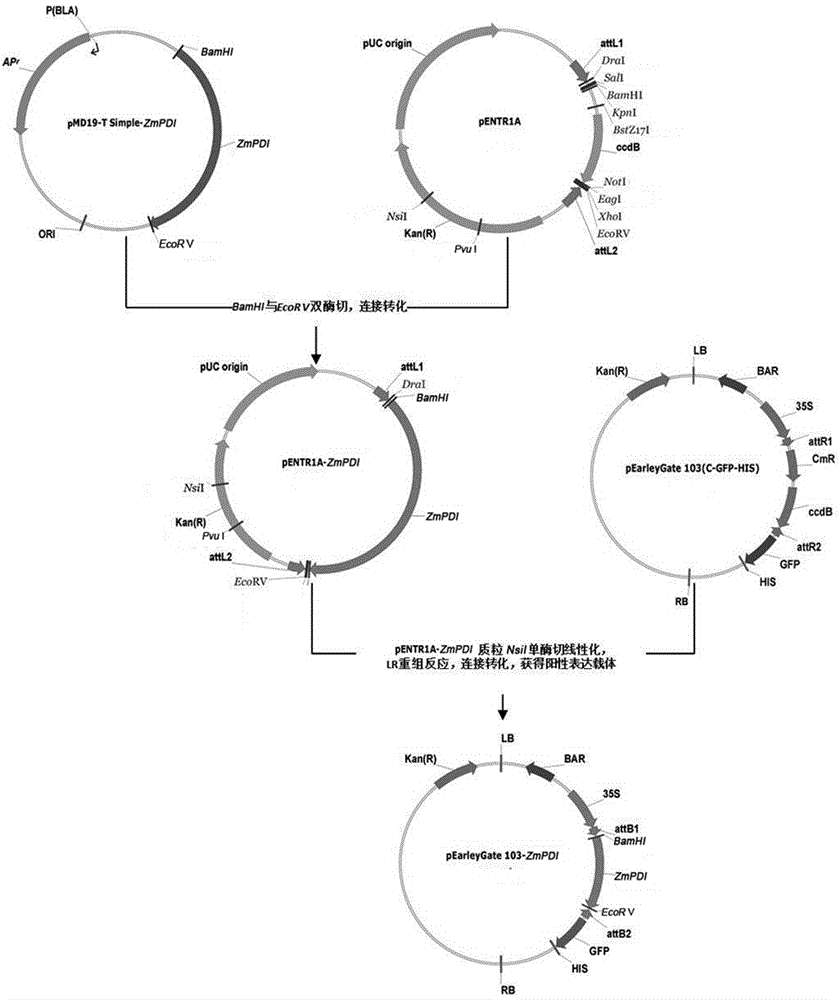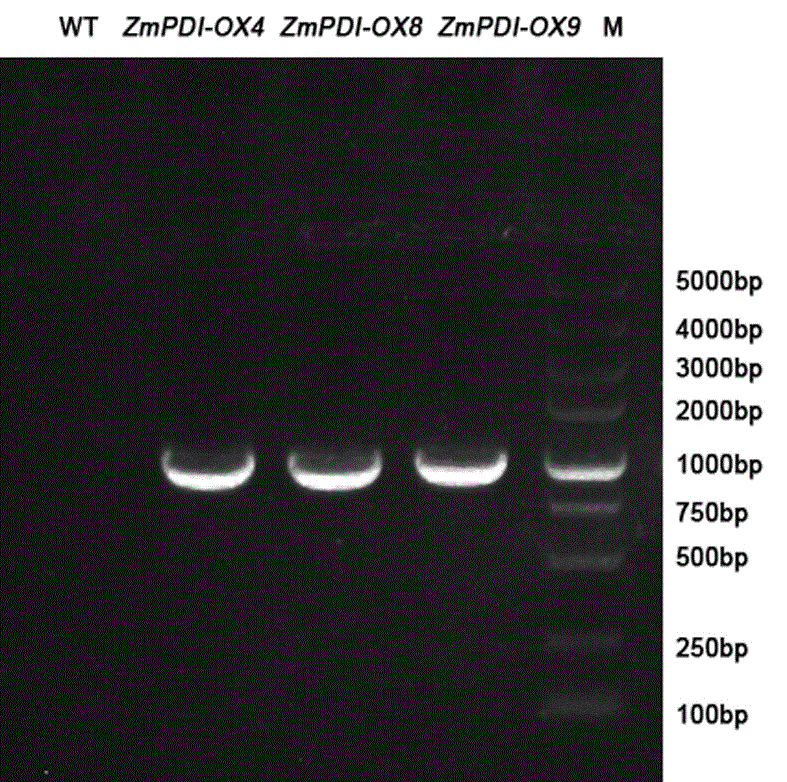New salt tolerance gene ZmPDI in zoysia matrella and plant expression vector and application of new salt tolerance gene ZmPDI
A plant expression vector, the technology of Zoysia dulcis, applied in the field of molecular biology to achieve the effect of improving salt tolerance
- Summary
- Abstract
- Description
- Claims
- Application Information
AI Technical Summary
Problems solved by technology
Method used
Image
Examples
Embodiment 1
[0029] Example 1 Zoysia folium ZPDI clone of ( figure 1 ).
[0030] Choose Zoysia ditch leaves ( Zoysia matrella ) as materials, select healthy turf pieces, place them in a cup filled with quartz sand, and culture them in 1 / 2 Hongland nutrient solution for 20 days, then transfer them to 1 / 2 Hongland nutrient solution containing 300mM NaCl for 7 days, take 0.1g of young leaves, according to the instructions of the Trizol RNA Extraction Kit (TaKaRa), extract the total RNA of the leaves, follow the M-MLV Reverse Transcription Kit (TaKaRa) to take 1 µg of total RNA and reverse transcribe into cDNA, and digest the cDNA with RNase products, designed primers to amplify ZPDI ;
[0031] Upstream primer ZmPDI-F: 5′-ATGGCGATCCACTCCAGGGT-3′ (SEQ ID NO.2);
[0032] Downstream primer ZmPDI-R: 5′-GAGCTCATCCTTGACGGCCT-3′ (SEQ ID NO.3).
[0033] Using the extracted leaf cDNA as a template, carry out PCR reaction, 20 µL reaction system: 10 µL of 2×RCR Mix, 1.0 µL each of ZmPDI-F and ZmP...
Embodiment 2
[0034] Example 2 Plant expression vector pEarleyGate103- ZPDI build ( figure 2 ).
[0035] Design primers for PCR reaction in target gene ZPDI Respectively introduce enzyme cutting sites upstream and downstream Bam H I and EcoR V. The PCR product was connected to the pMD19-T Simple vector, transformed into TOP10 competent cells, and the positive plasmid was extracted. Bam H I and EcoR Ⅴ double digested ZPDI fragment with Bam H I and EcoR Ⅴ The double-digested pENTR1A was ligated, transformed, and the extracted positive plasmid was Nsi ⅠAfter linearization by single enzyme digestion, carry out LR recombination reaction (Invitrogen) with pEarleyGate103 vector plasmid, transform, extract positive plasmid, electrophoresis detection and sequencing verification as SEQ ID NO.1;
[0036] Upstream primer ZmPDI- Bam HⅠ-F: 5′-GGATCCGGATGGCGATCCACTCCAGGGT-3′ (SEQ ID NO.4);
[0037] Downstream primer ZmPDI- EcoR V-R: 5'-GATATCTGAGCTCATCCTTGACGGCCT-3' (SEQ ID NO. 5). ...
Embodiment 3
[0041] Example 3 Plant expression vector pEarleyGate103- ZPDI Genetic transformation of Arabidopsis thaliana and identification of its salt tolerance.
[0042] ①Competent preparation of Agrobacterium strain EHA105 and transformation by freeze-thaw method: Pick a single colony of EHA105 from a YEB (50 µg / mL rifampicin) plate and inoculate it in 50 mL of YEB liquid medium containing 50 µg / mL rifampicin medium, 220 rpm, 28°C to OD value 0.6, then ice-bathed the bacteria solution for 30 min, centrifuged to collect the bacteria, suspended in 2 mL of pre-cooled 100mM CaCl 2 (20% glycerol) solution, 200 µL / tube for use; take 5 µL pEarleyGate103- ZPDI Add 100 µL of competent cells to the vector plasmid, ice bath for 30 min, freeze in liquid nitrogen for 5 min, 37°C for 5 min, add 800 µL of YEB liquid medium, pre-culture for 3 h at 28°C and 200 rpm, and smear the bacterial solution on YEB ( 50 µg / mL rifampicin + 50 µg / mL kanamycin) solid medium, cultured in the dark at 28°C for 2 day...
PUM
 Login to View More
Login to View More Abstract
Description
Claims
Application Information
 Login to View More
Login to View More - Generate Ideas
- Intellectual Property
- Life Sciences
- Materials
- Tech Scout
- Unparalleled Data Quality
- Higher Quality Content
- 60% Fewer Hallucinations
Browse by: Latest US Patents, China's latest patents, Technical Efficacy Thesaurus, Application Domain, Technology Topic, Popular Technical Reports.
© 2025 PatSnap. All rights reserved.Legal|Privacy policy|Modern Slavery Act Transparency Statement|Sitemap|About US| Contact US: help@patsnap.com



